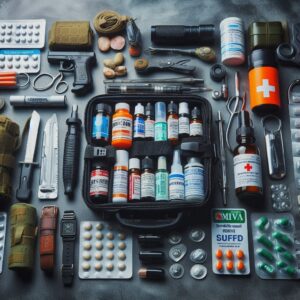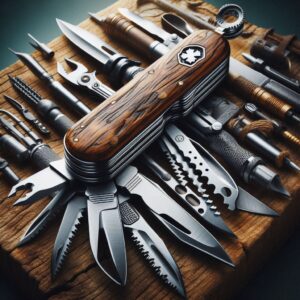Let’s chat about something important—being prepared. Now, I know what you’re thinking: “Prepared for what? The apocalypse? A zombie invasion? My little brother stealing my snacks?” Well, maybe not the zombie part (although who knows), but when it comes to being ready for anything life throws your way, it’s better to have it and not need it than to need it and not have it. That’s where prepper essentials come in.
 Picture this: you’re hanging out at home, watching your favorite show, and suddenly—BAM!—the power goes out, the fridge stops humming, and the Wi-Fi… well, let’s just say, it’s taking a nap. It’s not the end of the world, but wouldn’t it be nice to have a backup plan?
Picture this: you’re hanging out at home, watching your favorite show, and suddenly—BAM!—the power goes out, the fridge stops humming, and the Wi-Fi… well, let’s just say, it’s taking a nap. It’s not the end of the world, but wouldn’t it be nice to have a backup plan?
That’s the whole idea behind prepping. It’s about having the right stuff on hand so you’re not left scratching your head and wishing you’d listened to that one friend who’s always talking about emergency kits.
Maybe you want to be ready for a natural disaster, or perhaps you’re just tired of being caught off guard when the grocery store runs out of your favorite snacks. Whatever your reason, let’s chat about some prepper essentials that’ll help you feel like a survival pro—without needing to wear camo pants or live in a bunker.
So, let’s dive into the must-haves. And no, you don’t need to live in a bunker or wear camouflage 24/7 to be a prepper. Just some common sense, a little planning, and a few essentials.
Why You Need to Prep
First off, why should you even bother prepping? Well, life can be unpredictable—like that time my dog decided he was part cat and climbed up onto the roof.
Prepping is about being ready for anything life throws at you—natural disasters, economic downturns, or even just an unexpected snowstorm that leaves you stranded at home with only canned beans for company.
So, what do you need in your prepper arsenal? Let’s break it down!
Water: The MVP of Life
 If there’s one thing you absolutely cannot live without, it’s water. And I’m not just talking about having a bottle or two in the fridge. We’re talking gallons—like, a lot of them. The rule of thumb is about one gallon per person per day.
If there’s one thing you absolutely cannot live without, it’s water. And I’m not just talking about having a bottle or two in the fridge. We’re talking gallons—like, a lot of them. The rule of thumb is about one gallon per person per day.
So, if you’re planning to hunker down for a while, you better make sure you’ve got enough H2O to keep everyone hydrated and happy.
Store, Store, Store: Get yourself some large water containers, and fill them up. Keep them in a cool, dark place, and make sure they’re sealed tight. You can survive without food for weeks but only days without water. Aim for at least one gallon per person per day. And don’t forget those fancy water purification tablets—they’re like magic potions for turning questionable water into something drinkable.
Water Purification: In case you run out of the good stuff, have a way to purify more. Whether it’s water purification tablets, a portable filter, or good old-fashioned boiling, you’ll want to make sure whatever water you find is safe to drink.
Don’t Forget the Pets: If you’ve got furry friends, they need water too! Make sure you’ve got extra set aside for them.
Food – Because Hunger is Not a Survival Strategy
 Let’s be real, nobody wants to face an emergency on an empty stomach. That’s where your food stash comes in. But we’re not talking about gourmet meals here—think practical, long-lasting, and easy to prepare.
Let’s be real, nobody wants to face an emergency on an empty stomach. That’s where your food stash comes in. But we’re not talking about gourmet meals here—think practical, long-lasting, and easy to prepare.
Non-Perishables Are Your Friends: Canned goods, dried beans, rice, pasta, peanut butter—these are the unsung heroes of any prepper’s pantry. They last forever (okay, not literally, but close enough) and can be whipped up into something tasty even when your options are limited.
MREs (Meals Ready to Eat): These are like astronaut food but for regular people. They’re designed to last and don’t require a full kitchen to prepare. Just add water, heat (sometimes optional), and boom—dinner is served.
Snacks and Comfort Food: Don’t forget to throw in some treats. Chocolate, nuts, dried fruit—these little luxuries can make a tough situation feel just a bit more bearable. Stock up on granola bars and nuts; they keep your spirits high when everything else feels low.
First Aid Kit: Your Personal ER in a Box
 Accidents happen—trust me; I once managed to trip over my own feet while walking in a straight line. When it comes to bumps, bruises, and unexpected ouchies, a first aid kit is a non-negotiable. You don’t need to be a doctor to know that having the right supplies can make all the difference.
Accidents happen—trust me; I once managed to trip over my own feet while walking in a straight line. When it comes to bumps, bruises, and unexpected ouchies, a first aid kit is a non-negotiable. You don’t need to be a doctor to know that having the right supplies can make all the difference.
Basic Supplies: Band-aids, gauze, antiseptic wipes, and adhesive tape. These are the basics, but they’re the first things you’ll reach for when you get a scrape or cut. It’s like having your very own mini hospital at home!
Medications: Keep a stash of any prescription meds you or your family need, plus over-the-counter essentials like pain relievers, allergy meds, and something for upset stomachs. You never know when someone might need their “I-can’t-believe-I’m-sneezing” fix. Emergencies aren’t the time to run out of ibuprofen.
Tools and Extras: Scissors, tweezers, a thermometer, and a good old-fashioned first aid manual. Throw in some gloves and a CPR mask, too, just in case.
Tools and Gadgets – The Swiss Army Knife Approach
 Now we’re getting into the fun stuff—the tools! Having the right gear can make all the difference when things go sideways. If MacGyver taught us anything, it’s that the right tool can get you out of a sticky situation. When it comes to survival, having a few key gadgets on hand is crucial.
Now we’re getting into the fun stuff—the tools! Having the right gear can make all the difference when things go sideways. If MacGyver taught us anything, it’s that the right tool can get you out of a sticky situation. When it comes to survival, having a few key gadgets on hand is crucial.
Multi-Tool: This is like the Swiss Army knife on steroids. This little gadget is like Batman’s utility belt but way less flashy. It’s got everything from pliers to a can opener, and it’s small enough to carry with you everywhere.
Flashlights and Batteries: When the lights go out, you’ll want to have a reliable source of light. LED flashlights are bright, long-lasting, and don’t drain batteries too quickly. Speaking of batteries, stock up on those too—lots of them.
Radio: What happens if cell towers go down? It’s not exactly ideal if everyone’s running around yelling “Where are you?” like it’s a game of hide-and-seek. An emergency radio can keep you in the loop if your phone’s out of commission.
Look for one that’s battery-operated or, even better, crank-powered. Some even come with a built-in flashlight or phone charger. Write down important numbers on paper—because technology has its quirks—and keep it somewhere easy to find.
Fire Starter: Whether it’s matches, a lighter, or a flint and steel, you’ll need a way to get a fire going. And no, rubbing sticks together is not a reliable plan.
Hygiene and Sanitation – Because Smelling Like a Caveman Is Not Cool
Let’s not forget the basics of staying clean. Just because you’re in survival mode doesn’t mean you have to live like a caveman.
Soap and Hand Sanitizer: Keeping clean is key to staying healthy. A little bit of soap goes a long way, and hand sanitizer is a must if water is in short supply.
Toilet Paper: Believe it or not, toilet paper is one of those things you really don’t want to run out of. If you do, well, let’s just say you’ll get creative—fast.
Trash Bags: These are great for keeping your area clean and can double as rain ponchos or waterproof storage in a pinch.
Shelter and Warmth – Because Being Cold is No Fun
If you find yourself without your usual roof over your head, staying warm and dry becomes a priority. You don’t need a full-blown tent to survive, but you do need some basics.
Blankets and Sleeping Bags: A good, warm blanket or sleeping bag can mean the difference between a cozy night’s sleep and a shivering mess. Get ones that are rated for cold weather, just in case.
Tarps and Rope: Tarps are like the duct tape of shelter—they’re versatile and can be used for everything from making a quick tent to covering up your gear. Rope or paracord helps tie it all together.
Extra Clothes: Pack some extra clothes in a waterproof bag. Think layers—like a warm jacket, socks, and gloves. Staying dry and warm is key to avoiding hypothermia.
Communication – Because It’s Nice to Know What’s Going On
In an emergency, staying connected with the outside world—or at least your neighbors—is a good idea. Even if you’re hunkered down, you’ll want to know what’s happening.
Cell Phone and Charger: Keep your phone charged and have a backup power source, like a portable battery pack or solar charger.
Whistle: A whistle is a simple yet effective way to signal for help. Three blasts is the universal signal for distress.
Notebook and Pen: It might seem old-school, but having a way to write down important info or leave a message could come in handy.
Mental Preparedness – Stay Cool Under Pressure
Finally—and this is key—don’t forget about mental preparedness! Sometimes all the supplies in the world won’t help if panic sets in:
– Stay Calm: Practice breathing techniques or meditation to keep yourself grounded during stressful times—it works better than counting sheep!
– Educate Yourself: Take courses on basic survival skills or first aid training; knowledge is power! Plus, you’ll impress everyone at parties with your newfound expertise.
Remember that prepping doesn’t mean living in fear; it means taking control so that when life throws curveballs—or squirrels—you’ll be ready to dodge them like a champ!
Prepping isn’t about living in fear; it’s about being smart and ready for whatever comes your way. It’s like having a safety net under your trapeze act—just in case you slip, you know you’ve got something to catch you.
And remember, prepping doesn’t have to be all or nothing. Start small, gather the basics, and build from there. Every little bit helps. Think of it as your own personal insurance policy against the unknown. You’ve got this, and with the right prepper essentials, you’ll be ready to tackle whatever comes your way—zombie apocalypse or not.
